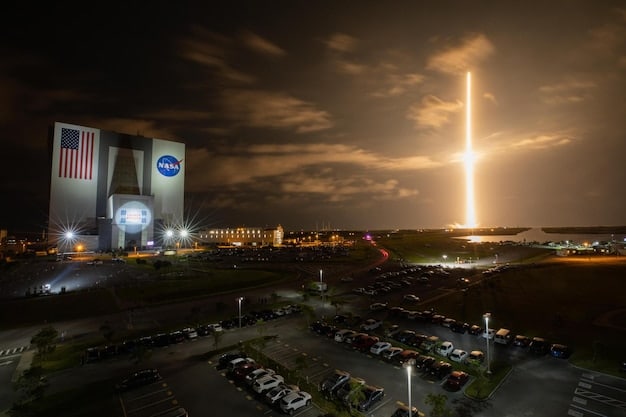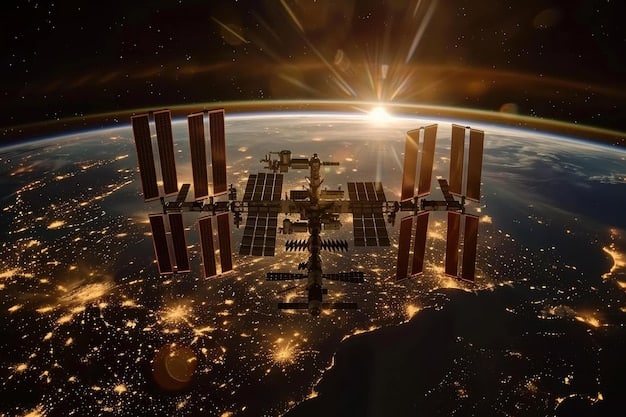Space Tech Race: US Commercial Spaceflight Future After Latest Launch

Following the recent advancements in space technology and successful launches, the US commercial spaceflight sector is poised for significant growth and innovation, focusing on enhanced capabilities, increased accessibility, and expanded missions, all while navigating the complexities of international competition and technological development.
The space tech race: what’s next for US commercial spaceflight after the latest launch? It’s a question that ignites the imagination and drives innovation in the modern era. This article delves into the current state and future trajectory of US commercial spaceflight after the most recent advancements.
The Current Landscape of US Commercial Spaceflight
The US commercial spaceflight sector has undergone a remarkable transformation in recent years. Driven by private companies and supported by government initiatives, it has become a vibrant and competitive arena. Current advancements and recent launches are reshaping the industry, setting the stage for future innovations.
Key Players in the Commercial Space Race
Several companies are at the forefront of the US commercial spaceflight sector, each contributing unique capabilities and expertise.
- SpaceX: Led by Elon Musk, SpaceX has revolutionized space travel with its reusable rockets and ambitious plans for Mars colonization.
- Blue Origin: Founded by Jeff Bezos, Blue Origin focuses on developing reusable launch vehicles and space tourism, aiming to make space accessible to more people.
- Virgin Galactic: Specializing in space tourism, Virgin Galactic offers suborbital flights for paying customers, providing a unique experience of weightlessness and stunning views of Earth.
- Boeing: A long-standing player in the aerospace industry, Boeing contributes to commercial spaceflight through its partnerships with NASA and development of crewed spacecraft like the Starliner.
These companies are not only competing but also collaborating in various ways to advance space technology and exploration.
Recent Milestones and Achievements
Recent launches and achievements have marked significant progress in the commercial spaceflight sector.
- Successful orbital missions by SpaceX, including cargo deliveries to the International Space Station (ISS) and crewed missions.
- Blue Origin’s suborbital flights with paying customers, demonstrating the potential for space tourism.
- Advancements in reusable rocket technology, reducing the cost of space travel and increasing the frequency of launches.
- The development of new spaceports and launch facilities across the US, expanding access to space for commercial ventures.
These milestones are paving the way for more ambitious projects and wider participation in space activities.
In conclusion, the US commercial spaceflight sector is currently characterized by dynamic competition, technological innovation, and significant milestones that are setting the stage for future growth and exploration.
Technological Innovations Driving the Space Race
Technological innovation is the engine that drives the space race, enabling new capabilities and pushing the boundaries of what is possible. Advanced materials, propulsion systems, and autonomous technologies are crucial for the future of commercial spaceflight.

Advanced Materials and Manufacturing
The development of advanced materials and manufacturing techniques is essential for building lighter, stronger, and more efficient spacecraft.
- Carbon Fiber Composites: These materials offer high strength-to-weight ratios, reducing the mass of spacecraft and improving fuel efficiency.
- 3D Printing: Additive manufacturing allows for the creation of complex parts with intricate designs, reducing manufacturing time and costs.
- Self-Healing Materials: Research into materials that can repair themselves in space is crucial for long-duration missions and reducing maintenance requirements.
- Aerogels: These ultralight materials provide excellent insulation, protecting spacecraft from extreme temperatures in space.
These innovations are enabling the creation of more robust and cost-effective spacecraft.
Propulsion Systems and Fuel Efficiency
Advancements in propulsion systems are critical for increasing the speed, range, and efficiency of space missions.
- Reusable Rocket Engines: Engines like SpaceX’s Raptor and Blue Origin’s BE-4 are designed for multiple uses, significantly reducing the cost of launches.
- Electric Propulsion: Ion thrusters and other electric propulsion systems offer high efficiency for long-duration missions, although they provide lower thrust compared to chemical rockets.
- Nuclear Propulsion: Research into nuclear thermal and nuclear electric propulsion systems promises higher thrust and efficiency for interplanetary travel.
- Green Propellants: Development of non-toxic propellants like liquid oxygen and methane reduces environmental impact and enhances safety.
These advancements are essential for enabling more frequent and cost-effective space missions.
In summary, technological innovations in advanced materials, propulsion systems, and automation are transforming the space race, making space more accessible and enabling new types of missions.
The Role of Government and Policy in Space Tech
Government policies and regulations play a crucial role in shaping the trajectory of the space tech race, influencing investment, innovation, and international cooperation. Supportive policies can foster growth, while restrictive regulations can hinder progress.
NASA’s Role in Commercial Space Development
NASA has been instrumental in fostering the growth of the US commercial space sector through various programs and initiatives.
- Commercial Crew Program: This program supports the development of crewed spacecraft by private companies, enabling the US to regain independent access to the ISS.
- Small Business Innovation Research (SBIR) and Small Business Technology Transfer (STTR) Programs: These programs provide funding for small businesses to develop innovative space technologies.
- Technology Transfer Programs: NASA shares its knowledge and technologies with private companies, helping them to develop new products and services.
- Space Act Agreements: These agreements allow NASA to collaborate with private companies on research and development projects, sharing resources and expertise.
NASA’s support is crucial for fostering innovation and competition in the commercial space sector.
Regulatory Framework and Space Law
The regulatory framework governing space activities is complex and evolving, encompassing issues such as launch licensing, spectrum allocation, and space debris mitigation.
- Launch Licensing: The Federal Aviation Administration (FAA) regulates commercial launches in the US, ensuring safety and compliance with environmental regulations.
- Spectrum Allocation: The Federal Communications Commission (FCC) allocates radio spectrum for communication with spacecraft, ensuring reliable communication links.
- Space Debris Mitigation: Efforts are underway to develop international guidelines and technologies for reducing and removing space debris, protecting spacecraft and ensuring the long-term sustainability of space activities.
- Property Rights in Space: Debates continue over the ownership of resources extracted from asteroids and other celestial bodies, raising complex legal and ethical questions.
Clear and effective regulations are essential for promoting responsible and sustainable space activities.
In conclusion, the government’s role in space tech is pivotal, with NASA’s support programs and the regulatory framework shaping innovation, investment, and the long-term sustainability of space activities.
Challenges and Opportunities in Commercial Spaceflight
The commercial spaceflight sector faces numerous challenges, including high costs, technological risks, and regulatory uncertainties. However, it also presents immense opportunities for economic growth, scientific discovery, and human exploration.

Addressing the High Costs of Space Travel
One of the biggest challenges in commercial spaceflight is reducing the cost of launches and operations.
- Reusable Rockets: Developing and refining reusable rocket technology is essential for lowering launch costs and increasing the frequency of missions.
- Standardized Components: Using standardized components and modular designs can reduce manufacturing costs and improve reliability.
- Automation and Robotics: Automating spacecraft operations and using robots for in-space construction and maintenance can reduce labor costs.
Reducing costs is crucial for making space more accessible to a wider range of users.
Managing Risks and Ensuring Safety
Spaceflight is inherently risky, and ensuring the safety of astronauts and the public is paramount.
- Redundancy and Reliability: Designing spacecraft with redundant systems and rigorously testing components can reduce the risk of failures.
- Emergency Escape Systems: Developing reliable emergency escape systems is crucial for protecting astronauts in the event of a launch or in-flight anomaly.
- Crew Training and Simulation: Providing astronauts with extensive training and realistic simulations can prepare them for the challenges of spaceflight.
Effective risk management is essential for ensuring the safety and sustainability of commercial spaceflight.
In summary, while the commercial spaceflight sector faces challenges such as high costs and inherent risks, the opportunities for economic growth, scientific discovery, and human exploration make overcoming these hurdles worthwhile.
Future Trends and Predictions
The future of US commercial spaceflight holds immense promise, with numerous trends and predictions shaping the industry’s trajectory. From space tourism to lunar missions and beyond, the possibilities are vast and exciting.
Space Tourism and Private Astronaut Missions
Space tourism is gaining momentum as a viable commercial venture, with companies like Virgin Galactic and Blue Origin offering suborbital flights to paying customers.
- Suborbital Flights: These flights provide a brief experience of weightlessness and stunning views of Earth, attracting wealthy individuals seeking unique adventures.
- Orbital Tourism: Companies like SpaceX are offering orbital flights for private citizens, allowing them to spend several days in space and even visit the ISS.
- Space Hotels: Plans are underway to build commercial space stations that will serve as hotels, offering tourists extended stays in orbit.
Space tourism has the potential to generate significant revenue and drive innovation in the space sector.
Lunar Missions and Commercial Lunar Landers
The Moon is becoming a major focus of commercial space activities, with NASA’s Artemis program and private companies planning lunar missions.
- Commercial Lunar Payload Services (CLPS): This NASA program supports the development of commercial lunar landers, enabling the delivery of scientific instruments and other payloads to the Moon.
- Resource Extraction: Companies are exploring the possibility of extracting water ice and other resources from the Moon, which could be used to produce rocket fuel and support future lunar settlements.
- Lunar Habitats: Plans are underway to build permanent lunar habitats, providing a base for astronauts and researchers to live and work on the Moon.
Lunar missions are paving the way for a sustained human presence on the Moon and beyond.
In conclusion, the future trends in US commercial spaceflight are marked by advancements in space tourism, lunar missions, and the potential for resource extraction, promising a dynamic and expanding industry.
International Competition and Collaboration
The space tech race is not limited to the US; it is a global endeavor with increasing international competition and collaboration. Understanding the dynamics of this global arena is crucial for the future of US commercial spaceflight.
- China’s Space Program: China has made significant strides in space technology, including launching its own space station and conducting lunar missions.
- European Space Agency (ESA): ESA is involved in numerous international space projects, including the development of launch vehicles and scientific missions.
- India’s Space Research Organisation (ISRO): ISRO has gained recognition for its low-cost space missions, including the Mars Orbiter Mission and the Chandrayaan lunar missions.
These international players are contributing to the advancement of space technology and exploration.
Opportunities for International Partnerships
Despite the competition, there are also opportunities for international collaboration in space activities.
- Joint Missions: Countries can pool their resources and expertise to conduct joint missions, such as exploring Mars or studying climate change.
- Data Sharing: Sharing data from space-based sensors can improve our understanding of Earth and the universe.
- Technology Exchange: Exchanging technologies can accelerate the development of new space capabilities and reduce costs.
International partnerships can foster innovation and promote global cooperation in space.
In summary, international competition and collaboration are key aspects of the space tech race, with numerous countries contributing to the advancement of space technology and exploration, and offering opportunities for partnerships.
| Key Point | Brief Description |
|---|---|
| 🚀 Commercial Growth | Significant expansion driven by private companies and NASA support. |
| 🛰️ Tech Innovation | Advanced materials, propulsion systems, and automation crucial for progress. |
| ⚖️ Policy Impact | Government policies shape investment, innovation, and international engagement. |
| 🌍 Global Dynamics | International competition and collaboration influence the space tech race. |
FAQ
▼
The main drivers include technological innovations like reusable rockets, government support from NASA, and increasing private investment aimed at space tourism and resource exploration.
▼
NASA supports commercial space development through programs like the Commercial Crew Program, SBIR grants, technology transfer initiatives, and collaborative Space Act Agreements.
▼
Key challenges include the high costs of space travel, managing inherent technological risks, navigating complex regulatory frameworks, and mitigating long-term issues such as space debris.
▼
International competition drives innovation as countries like China and India advance rapidly, pushing the US commercial sector to innovate and collaborate globally to maintain its competitive advantage.
▼
Future trends include the growth of space tourism, increased lunar missions for research and resource extraction, and the development of commercial space stations to support long-term orbital habitation.
Conclusion
In conclusion, the US commercial spaceflight sector is at a pivotal moment, poised for significant advancements and expansion driven by technological innovations, government support, and private investment. The future promises increased accessibility to space, new opportunities for exploration, and sustained international collaboration, cementing the US as a leader in the evolving space tech race.